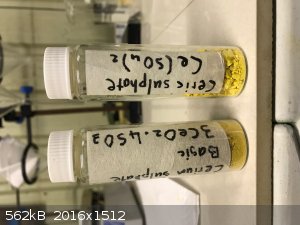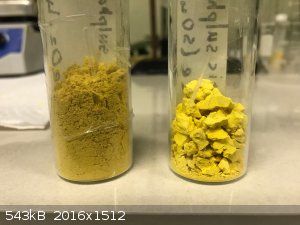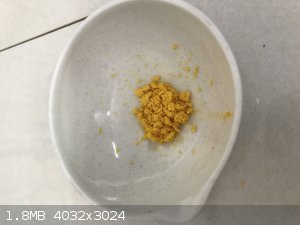Lion850
National Hazard
   
Posts: 517
Registered: 7-10-2019
Location: Australia
Member Is Offline
Mood: Great
|
|
Report on making cerium sulfate
After a few experiments spread out over weeks attempting to make different cerium salts from cerium oxide CeO2 I eventually realised that with what I
had at hand reacting the CeO2 with hot concentrated sulphuric acid was the easiest.
One of my initial attempts was to react CeO2 with a slight excess of 98% H2SO4 in a crucible in a sand bath at around 200 C. The CeO2 dissolved easily
forming a yellow-red wet thick liquid. I continued to heat this in the sand bath maintaining around 200 C. Eventually there was no more acid fumes
coming off but it was still liquid. Upon cooling this solidified into a dry mass with off-yellow color. I broke this up and into a coarse powder and
transferred it to a vial.
Reading up on atomistry http://cerium.atomistry.com/ceric_sulphate.html
I assume that what I got was the basic cerium sulfate 3CeO2.4SO3
The second time I dissolved CeO2 in 98% H2SO4 at lower temperature, the sand temperature was kept at around 140 C. A slightly larger excess of acid
was used. Again the CeO2 dissolved easily and formed a very wet orange paste. This paste was put in a desiccator over NaOH and under vacuum for 48
hours. I then had a wet yellow paste but in the bottom of the crucible was a hard reddish layer.
The red layer was removed and was found to be easily soluble in water. This is probably a hydrate of ceric sulfate.
The wet yellow paste went back into the desiccator but it did not dry any further and maintained a strong acid smell. Following what is mentioned in
Atomistry (link above) I transferred the yellow paste into a beaker with glacial acetic acid and stirred until it was a fine yellow suspended powder.
This solution was then filtered.
The yellow remainder was washed twice more with glacial acetic acid in the funnel. it was then scratched off the filter paper and into a crucible. It
was slowly turning orange as it was exposed to the moisture in the air during this process.
The crucible with the yellow (now slight orange) powder was transferred to a desiccator over 98% sulphuric acid as drying agent and under vacuum. The
color became more yellow over time. After 5 days it was removed as a yellow dry mass, this was broken into smaller pieces and quickly transferred to a
vial. It had a very faint vinegar smell from the acetic acid washing. If left in moist air it becomes wet and turns orange-brown. I assume this yellow
product is anhydrous ceric sulfate Ce(SO4)2.
Photos of both products below.
Both products dissolves easily in water, and then gives a ppt of cerium hydroxide when treated with ammonium solution. This cerium hydroxide, in turn,
easily dissolves in hydrochloric acid or nitric acid for making other cerium compounds, which was the initial object.
 
|
|
|
Bedlasky
International Hazard
    
Posts: 1240
Registered: 15-4-2019
Location: Period 5, group 6
Member Is Offline
Mood: Volatile
|
|
Nice preparation!
I also plan to do some cerium chemistry. But only in test tube scale. I have 3g of metallic cerium, which will be my starting point.
|
|
|
Lion850
National Hazard
   
Posts: 517
Registered: 7-10-2019
Location: Australia
Member Is Offline
Mood: Great
|
|
Update: I left some of the yellow dehydrated crystals out overnight. The next morning they were increased in volume and now more orange. It must have
absorbed moisture from the air overnight and is now probably one of the hydrates - the Wikipedia says the tetrahydrate is yellow-orange. Photo below.

|
|
|
Boffis
International Hazard
    
Posts: 1868
Registered: 1-5-2011
Member Is Offline
Mood: No Mood
|
|
Have you tried recrystallising it to remove some of the excess sulphuric acid? Its tricky because it has a negative solubility gradient in water i.e.
its more soluble in the cold than hot water, so you have to saturate the solution in the cold, filter if necessary and then warm to precipitate the
sulphate and filter warm (don't overheat /boil as it hydrolyses). When I have done this I convert it into ceric ammonium sulphate by adding the cold
solution to a strong solution of a slight more than 4Molar equivalence of smmonium sulphate.
|
|
|
Lion850
National Hazard
   
Posts: 517
Registered: 7-10-2019
Location: Australia
Member Is Offline
Mood: Great
|
|
Hi Boffis my initial target was to make the yellow anhydrous sulfate, which rules our using water. After the washing with glacial acetic acid there
was no more sulphuric acid smell, but it had a faint vinegar smell!
I have used the negative solubility gradient effect to crystalize and filter off erbium and neodymium sulphates. I did not try this with cerium,
because as far as I know cerium sulphate changes to a different structure when the water temperature exceeds 70 C.
|
|
|